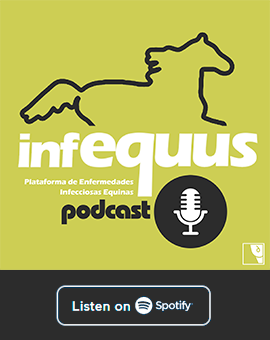Tetanus
Etiology
Tetanus is an acute zoonotic disease, caused by the exotoxins (tetanospasmin) of Clostridium tetani (or Nicolaier bacillus) belonging to the Clostridiaceae family. C. tetani is a gram-negative, catalase-negative, anaerobic bacterium with the capacity to form spherical terminal endospores larger than the vegetative cell, which are very resistant to heat and antiseptics. They are generally mobile due to the presence of peritrichous flagella.
Epidemiology
C. tetani has a worldwide distribution, affecting both humans and animals, horses being especially susceptible. The bacterium is located in the soil and in the manure, the disease being linked to areas where there are intensive production farms. The mild temperature and humidity conditions, as well as the neutral pH soils, favor the survival of the microorganism. Endospores are very resistant to environmental conditions and can be infective for periods of up to 40 years. Mortality in horses varies widely among regions, being, in general, high (50-80%), especially in developing countries where preventive vaccination is not usually practiced.
Pathogeny
Transmission is usually caused by the accidental inoculation of the spores by contaminated sharp objects or by the bite of animals and, rarely, by the bite of insects. Infection can also be caused by the contact of open wounds with dirt, dust, faeces or contaminated objects. Deep wounds are especially suitable for the multiplication of bacteria because they are more likely to create the necessary anaerobic conditions for the bacteria. C. tetani produces tetanospasmin and tetanolisin. Tetanolisin causes tissue damage, reducing the redox potential and favoring conditions for bacterial proliferation. Tetanospasmin binds irreversibly to the receptors of motor neurons, blocking nerve signals to the musculature, causing spastic paralysis with painful muscle spasms. In the case of septicemia, various muscle groups are affected, with the involvement of the muscles of the jaw and face being characteristic. The incubation period ranges from 24 hours to 54 days, being the average 14 days and varying depending on the proximity between the lesion and the central nervous system.
Clinical signs
The infection is characterized by the appearance of a descending spastic paralysis, with clinical signs associated with the muscles of the jaw and face causing the so-called lockjaw and sardonic laughter, by the bilateral and sustained contraction of the mastere muscles, producing difficulties in swallowing and hypersalivation Later, the paralysis extends to the neck and front limbs causing difficulty in walking ("wooden horse"). The spasms can be of great intensity producing muscular tears and bowing of the spine (opistotonos). It also produces an increase in body temperature and general weakness due to excessive energy expenditure, which causes postration. There is usually profuse sweating, hyperesthesia, photophobia and hyperacusis.
Diagnosis
The diagnosis is clinical, although the signs are not always pathognomonic and can be confused with intoxications due to strychnine or meningitis. A differential diagnosis should be made with cervical vertebral fracture, cervical osteomyelitis, colic, pleuritis, laminitis, meningitis or myopathies. If the veterinarian knows of a history of injuries in horses with clinical signs, you may increase the suspicion that you have tetanus.
Treatment
The treatment of a horse with tetanus includes the administration of parenteral antibiotics (penicillin G, chloramphenicol, metronidazole, piperalizine, imipenem), anti-tetanus serum (55,000 IU every 24 h for 3 days), sedatives and muscle relaxants. In addition, supportive therapy should be considered to ensure the correct maintenance of all the organic systems potentially affected by the disease, such as the gastrointestinal system, as well as the maintenance of the hydration status and the basal energy needs of the horse. If there is a wound, it should be debrided surgically and oxidizing agents applied to inactivate the bacteria. The horse must remain in a dark, silent environment, and as isolated as possible.
Prevention and control
There is a vaccine with effective tetanus toxoid. If a horse has not been vaccinated, it should be applied as soon as possible. A first dose of tetanus toxoid and a second booster dose are usually given 3-4 weeks later. New reinforcements must be applied at 6 months and a year. Pregnant mares should be vaccinated 4-6 weeks before the expected date of delivery to ensure the presence of antibodies in the colostrum. The foals of vaccinated mothers should be immunized at 4-5 months and if the mother was not vaccinated or is unknown at 3-4 months following the reinforcement protocol.
There is also the possibility to administer the antitoxin (anti-tetanus serum) preventively prior to a surgery; for example, a castration. However, there have been cases of Theiler´s disease (hepatitis) reported due to the contamination of the antitoxin with equine parvovirus.
Public Health Considerations
Tetanus is a zoonosis. Humans can become infected by contaminating open wounds with Clostridium tetani spores that horses or other herbivores disseminate through their feces in the environment. The person-person transmission does not occur. The risk of contracting the infection in the laboratory is low, but could be caused by accidental inoculation or exposure of open wounds. Therefore, correct hygiene practices are necessary and avoid contact of wounds with potentially contaminated material, as well as the use of personal protection equipment. There is an effective vaccine for humans recommended by the national health system, especially for workers with risk activities.
References
- Hanif H. et al., 2015. Isolation and antibiogram of Clostridium tetani from clinically diagnosed tetanus patients. Am. J. Trop. Med. Hyg. 93 (4):752-756. doi: 10.4269/ajtmh.
- Ribeiro MG. et al., 2018. Tetanus in horses: an overview of 70 cases. Pesq. Vet. Bras. 38 (2): 285-293.
- Gracner D. et al., 2015. A twenty-year retrospective study of tetanus in horses: 42 cases. Veterinarski Archiv. 85 (2). 141-149.
- Boletín Veterinario de Intervet. Año 1, Numero 6 Mayo-Junio. 2004. Salud Animal de Pequeñas Especies: Ni un solo caballo debería morir de tétanos.
- van Galen G. et al., 2017. Retrospective evaluation of 155 adult equids and 21 foals with tetanus from Western, Northern ad Central Europe (2000-2014). Part2: prognostic assessment. Journal of Veterinary Emergency and Critical Care. 27 (6): 697-706.
- Aguayo MJ. Tétanos en equinos. Universidad de las Américas.

